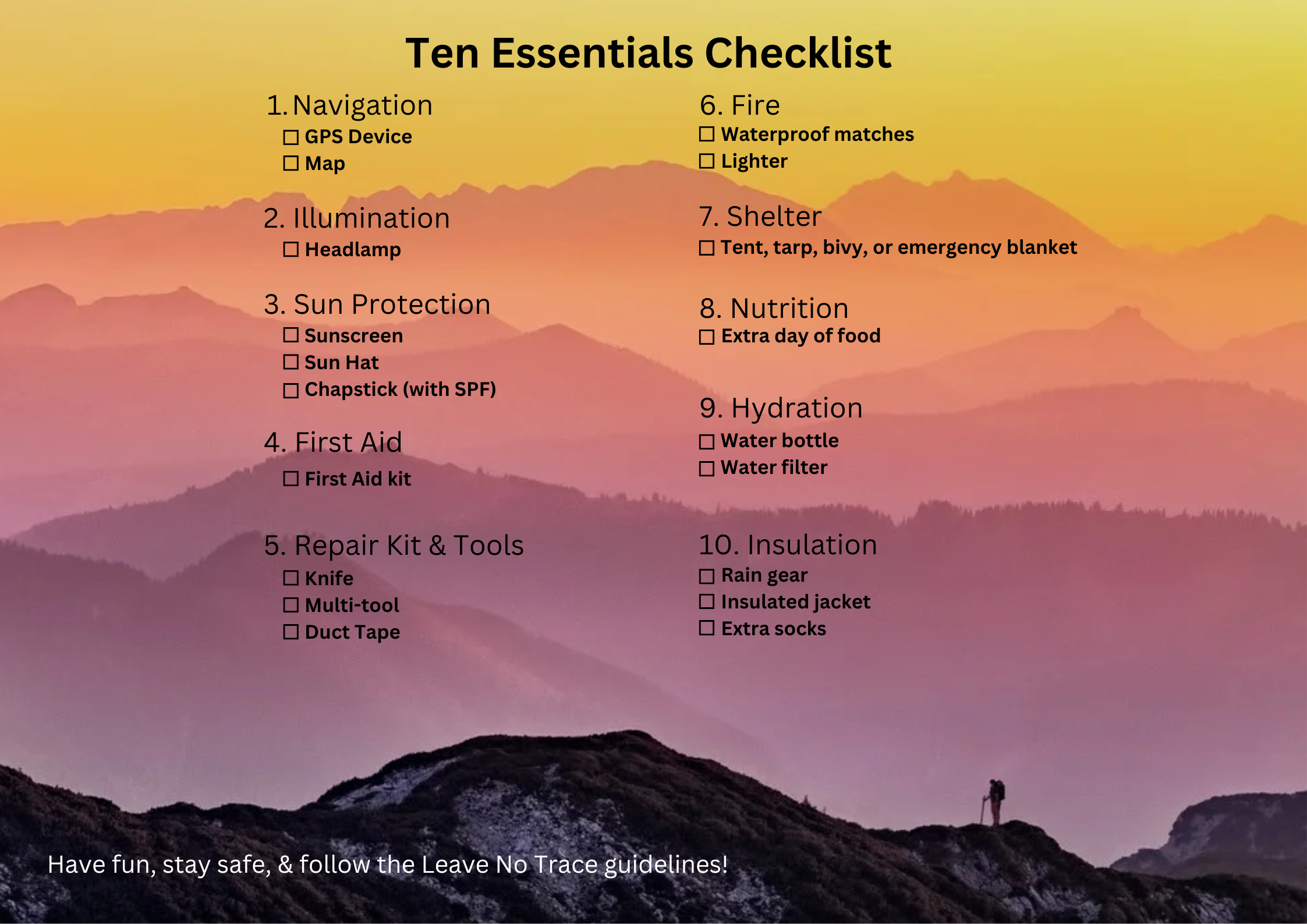The Ten Essentials
My friend and I were enjoying lunch at a beautiful lake on our second day on the John Muir Trail when an enormous smoke plume quickly filled the sky above us. So many thoughts started racing through my head. Where is all this smoke coming from? Is there a fire headed our way? Do we have enough time to get to camp? Where can we evacuate from if we need to?
Thankfully, we had a Garmin InReach (GPS Device) which we used to message someone back home and figure out what was going on. Immediately, we got a response with details on where the fire was and if it was safe to hike in the direction we were headed. We also used a paper map to determine the best evacuation route, if need be.
We left the lake and quickly hiked the remaining six miles to camp while it rained ash on our heads. When we finally arrived, we were covered head-to-toe in black ash. What a sight! We set up our tent and took cover for the night. Luckily, we woke up the next morning with favorable wind patterns which gave us enough time to make our next plan of action…
If it wasn’t for our various forms of navigation (GPS Device and paper map) or shelter (tent), we wouldn’t have been prepared for the unexpected wildfire headed our way.
The Ten Essentials were developed by the Mountaineers Club as a list of items intended to help you survive a night in the wilderness should things go wrong. Not every trip will require you to use them but they’re necessary to always carry with you, regardless of trip length or experience level.
1. Navigation (map, compass, GPS device)
Phones are rarely reliable in the backcountry so it’s important to have an alternate form of navigation. If you use a paper map or compass, make sure you know how to use them. It’s harder than you’d think!
2. Illumination (headlamp)
Always carry a headlamp (and extra batteries)! Even if you plan to end your hike before dark, delays happen and darkness comes fast. Hiking at night without a headlamp is a disaster waiting to happen.
3. Sun protection (sunscreen, sunglasses, sun hat, SPF chapstick)
At high altitudes in the mountains, middle of the day in the desert, or even in the snow, the sun is harsh. Sunscreen should be used on both sunny and cloudy days. Sunglasses protect from summer glare and winter snow blindness. Sun hats guard your face or scalp from burning. Chapstick with SPF is key. Trust me, don’t forget your chapstick!
4. First Aid (basic first aid kit plus more)
Nothing’s worse than getting cuts, bites, stings, or blisters and not having the proper supplies to treat them. You should also have an assortment of basic medications for both illness and injury. As you become more experienced, you’ll start to refine your first aid list.
5. Repair Kit & Tools (knife, multi-tool, duct tape)
You’ll end up using a multi-tool and duct tape more than you’d think. They can be used for gear repair, first aid, food prep, etc.
6. Fire (waterproof matches, lighter, fire starter)
Always bring waterproof matches and make sure they are in a sealed container. Fire starter is also smart to bring so that you can make a fire or signal for help in case of an emergency.
7. Shelter (tent, tarp, bivy, or emergency blankets)
Even for day hikes! If you are injured or stranded, you never know when you might have to spend the night outdoors.
8. Nutrition (extra food)
Always carry and extra day of food with you. You never know what will happen. Also, make sure the foods you do pack are lightweight and calorie dense.
9. Hydration (extra water)
Always carry at least one water bottle per person. While hiking, you should drink about 1L of water every 2 hours. Check water availability before leaving but never drink from an outdoor water source without purifying it first. Make sure to bring a water filter or water treatment system.
10. Insulation (rain clothes, additional layers of clothing, extra socks)
Weather is unpredictable. A sunny day could turn out to be cloudy or a rain storm could appear out of nowhere. You should prepared for the worst conditions you could possibly get.
*Please note that some of the links in this post are affiliate links and I may earn a small commission if you choose to make a purchase – at no additional cost to you. As an Amazon Associate I earn from qualifying purchases. These funds help make it possible for me to provide you with these resources. Thank you!


